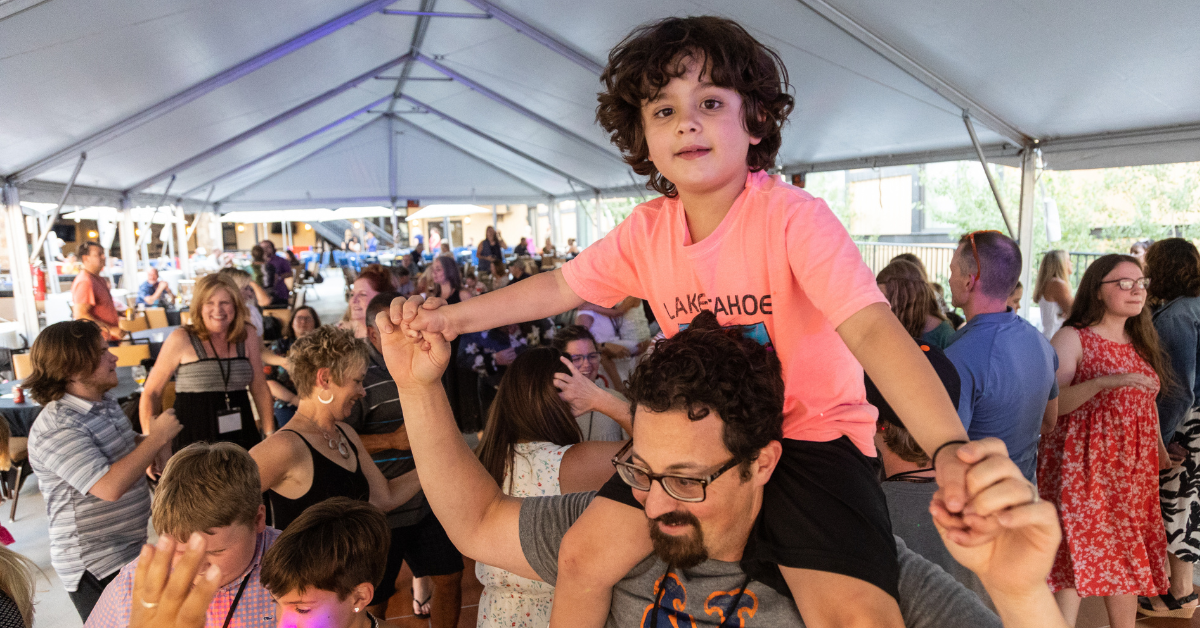Families enjoying the dance party at our family conference in 2022
Health Related Quality of Life After Pediatric Epilepsy Surgery
The #1 goal of any epilepsy surgery is either to stop seizures or reduce them. But an important secondary goal is to improve the child’s quality of life.
Thanks to a recent study, we know that epilepsy surgery can save lives. Now, new research shows that epilepsy surgery can also substantially improve a child’s quality of life.
How seizures affect daily living in children with refractory epilepsy
We know that drug-resistant seizures can disrupt a child’s daily life, leading to physical, emotional, cognitive, and psychological consequences.
Physical effects of frequent seizures
Frequent seizures can cause delays in meeting developmental milestones or regression. Children with drug-resistant epilepsy may experience limitations in their mobility and physical activities, making it challenging to participate fully in daily activities like eating and walking.
Emotional and psychological consequences
The emotional and psychological toll of living with drug-resistant epilepsy can be significant for children. The fear and anxiety associated with the unpredictability of seizures can lead to feelings of isolation, low self-esteem, and depression. Seizures can profoundly impact social interactions, relationships, education, and overall well-being. A child’s mental health can be very affected by seizures.
Impact on social interactions and relationships
Children with drug-resistant epilepsy may face challenges in forming and maintaining social relationships. The fear of having a seizure in public or being stigmatized due to their condition can lead to social withdrawal and feelings of isolation.
Influence on education and learning
The impact of seizures on a child’s education and learning should not be underestimated. Frequent seizures can disrupt cognitive function, attention, and memory, making it difficult for children with drug-resistant epilepsy to succeed in school.
What is Health-Related Quality of Life?
Health-related quality of life is a person’s or group’s perceived physical and mental health over time. In other words, it’s how good you feel physically and mentally as you go through life.
Epilepsy surgery and health-related quality of life
In the new study, researchers wanted to understand the course of a child’s health-related quality of life if they continued with medication or had epilepsy surgery.
The study involved children between the ages of 4 and 18 who had medication-resistant seizures. The researchers recruited participants from eight hospitals in Canada from 2014 to 2019.
- 265 children participated in this study
- 111 children had epilepsy surgery*
- 154 children received only medication to treat their epilepsy.
*Children who had already had epilepsy surgery, including vagus nerve stimulation and corpus callosotomy, were excluded from this study. Also excluded were children with neurometabolic disorders, neurodegenerative disorders, genetic epilepsy syndromes, and epileptic encephalopathies.
Health-related quality of life improves after epilepsy surgery
The study looked at the health-related quality of life of children over a 2-year period. Researchers asked parents to answer questions from the Quality of Life in Childhood Epilepsy Questionnaire.** The study found that the group of children who had surgery had a greater improvement in their quality of life compared to those who received treatment medication only.
At 6 months after surgery, the health-related quality of life of surgical patients was, on average, 3.0 points higher than the medication group, and at 1 year and 2 years, it was 4.9 and 5.1 points higher, respectively.
The study also found that children who started having seizures later in life, took fewer seizure medications, and had more support from their family tended to have a better quality of life.
- As a group, children who were treated only with medication had no change in their quality of life two years later.
- Individually, some children after surgery had improved quality of life and others had no change.
Social functioning was the main area that improved for the surgery group. The most significant increase in social functioning occurred within the first six months post-surgery, continued to improve over the next six months, and then remained stable two years after surgery.
The study also found that while surgery did not significantly improve physical, cognitive, or emotional functioning over the two-year period, it had an indirect effect on these areas if the child was seizure-free, which led to increased social inclusion, improved autonomy, reduced fear and anxiety, and enhanced opportunities for social interactions.
“This is the largest multi-center study that has assessed health-related quality of life outcome over time after epilepsy surgery in children. Our motivation for the study was driven by families’ desire to know whether epilepsy surgery can improve their child’s quality of life. This study provided evidence that epilepsy surgery in children can improve both seizure control and health-related quality of life, and therefore should NOT be considered the treatment of last resort.”
Dr. Elisa Widjaja, study co-author and Division Head of Neuroradiology, Department of Medical Imaging, Ann & Robert H. Lurie Children’s Hospital of Chicago
We need more research
One important cautionary point the researchers in this study noted was that we still need to understand the long term course of quality of life after epilepsy surgery. We know, for example, that seizure freedom after surgery may not last because the brain can develop new areas prone to seizures.
Larger studies with more children are needed before we can predict quality of life after surgery. If you want to help our community and researchers understand quality of life in the long run after surgery, please consider participating in our Global Pediatric Epilepsy Surgery Registry. It’s the only patient-powered research project to understand a child’s course of development, including quality of life, after surgery.
You can also rally for research by restricting your donation to our research fund here.
What this means for you
This study shows that epilepsy surgery helps most kids have fewer seizures and a better quality of life. This leads to doing better in school and jobs, and lowers both healthcare needs and costs. The results make a strong case for why surgery is worth it, and why more children should have access to it.
If your child has drug-resistant seizures, ask for a surgical evaluation at an epilepsy center with substantial experience treating your child’s epilepsy type. Make sure the whole team is experienced and properly trained. The bigger the surgery, or the newer the technique, the more experience the team will need.
Remember – having a surgical evaluation doesn’t mean you have decided your child will have surgery. It means you want to understand all your options so that you can make an informed health care decision for your child.
Understand all your child’s epilepsy surgery options
There are many surgical options available for your child ranging from minimally invasive techniques like laser ablation all the way to big surgeries like the hemispheric procedures. If your child is not a candidate for cranial epilepsy surgery, vagus nerve stimulation, responsive neurostimulation, or deep brain stimulation can provide hope for an improved quality of life.
Resources to help you navigate your child’s epilepsy surgery journey
You can help us get more children to surgical evaluation by supporting Dreams for Danny, our financial aid program that covers travel costs associated with surgical evaluation. We cover airfare, gas, meals, and other costs insurance won’t pay.
about the author

Monika Jones, JD, is our founder and executive director. Her first son, Henry, had a modified lateral hemispherotomy, revision surgery, then true anatomical hemispherectomy to stop seizures caused by total hemimegalencephaly. She is also the principal investigator of the Global Pediatric Epilepsy Surgery Registry, the only parent-reported data collection to understand the developmental trajectory after pediatric epilepsy surgery. You can read her research works at orcid.org/0000-0001-6086-3236.
Upcoming Events
Recent Posts
Stay Connected




